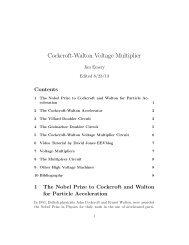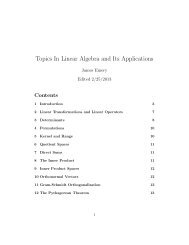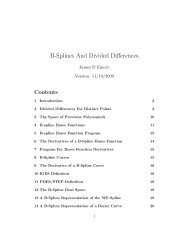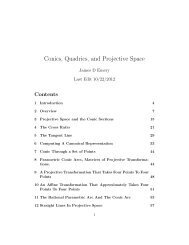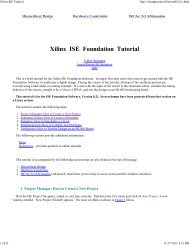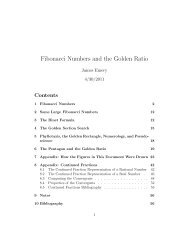Controlling a Rolling Ball On a Tilting Plane - STEM2
Controlling a Rolling Ball On a Tilting Plane - STEM2
Controlling a Rolling Ball On a Tilting Plane - STEM2
You also want an ePaper? Increase the reach of your titles
YUMPU automatically turns print PDFs into web optimized ePapers that Google loves.
12 A Mass Point in Circular Motion<br />
Let a mass point point be specified in polar coordinates (θ, r). Let the point<br />
be constrained to lie on a circle of radius r. Let the polar coordinate unit<br />
vectors be<br />
u r =cos(θ)i +sin(θ)j,<br />
u θ = − sin(θ)i +cos(θ)j.<br />
The first vector is perpendicular to the circle and the second is tangent to it.<br />
Let the position vector of the point be<br />
The velocity is<br />
p = ru r .<br />
v = dp<br />
dt = dr<br />
dt u r + r du r<br />
dt = r du r<br />
dt ,<br />
because here r is constant. We have<br />
du r<br />
dt = du r dθ<br />
dθ dt<br />
dθ<br />
= u θ<br />
dt .<br />
So<br />
v = r dθ<br />
dt u θ = rωu θ ,<br />
where ω is the angular velocity. The acceleration is<br />
a = dv<br />
dt = r dω<br />
dt u θ + rω du θ<br />
dt<br />
= r dω<br />
dt u θ − rω 2 u r<br />
= r dω<br />
dt u θ − v2<br />
r u r,<br />
where dω/dt is the angular acceleration, and v = rω is the tangential velocity.<br />
If the angular acceleration is zero then v 2 /r is the magnitude of the centrepital<br />
acceleration directed toward the center of the circle.<br />
11



